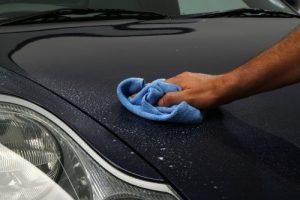What is the two bucket method
Written by: Vinnie van Rooij
The two-bucket method is possibly to most known and most used technique used by detailers and professionals, to wash a vehicle. It is one of 3 different types of washing a vehicle that are widely considered to be safe and correct ways of cleaning a surface.
What is the 2-bucket method
The two bucket method revolves around using 2 buckets to wash a vehicle. 1 bucket is filled with a shampoo/water solution, the other bucket is filled with clean water. The tool that is being used to wash the surface (washmitt, MF sponge etc.) is submerged into the bucket with the water/shampoo solution and used to wash the surface. When you are done, you rinse out the used tool in the bucket with clean water. When the tool is clean again, it can be submerged in the bucket with water/shampoo solution again to wash the next area.
Why use the two bucket method
If you would skip the rinsing step, the dirty tool (after washing the surface) will make the water/shampoo mixture dirty. The dirt it picked up will now be in the water. The next time to put that piece of equipment in the bucket, it will not only contain water with shampoo, but it will also contain small particles of dust and dirt. The longer you keep doing this, the more dirty the water will get. The more dirty the water is, the more dirty your tool is getting. Eventually you will be washing the surface with dirty water. Which can cause swirls and other surface imperfections.
To minimize the risk of swirls or other surface imperfections, it is important to rinse out the tool you are using. Only if it is really clean, it can move safely over the surface without scraping the dust and dirt over the surface. After having spend many hours polishing a vehicle, trying to make it look as perfect as possible, you don’t wanna create the swirls you jut removed.
Different related articles
 Carrand is a California, America based manufacturer of consumer car cleaning supplies. The company is a subsidiary of Hopkins Manufacturing from Kansas, America....
Carrand is a California, America based manufacturer of consumer car cleaning supplies. The company is a subsidiary of Hopkins Manufacturing from Kansas, America.... There are 2 general ways for deep cleaning fabric. Using a vacuum cleaner (just removing surface dirt), or using a wet/dry vacuum cleaner (deep clean the fabric). When you deep clean fabric, you need to take into account that you will spent a lot more time on it....
There are 2 general ways for deep cleaning fabric. Using a vacuum cleaner (just removing surface dirt), or using a wet/dry vacuum cleaner (deep clean the fabric). When you deep clean fabric, you need to take into account that you will spent a lot more time on it.... AMMO NYC is a detailing products manufacturer with the slogan "Drive + Protect". The brand offers a small range of products aimed at the most common steps in the detailing process. ...
AMMO NYC is a detailing products manufacturer with the slogan "Drive + Protect". The brand offers a small range of products aimed at the most common steps in the detailing process. ... Waterless washing is a technique in which no water is used to clean the surface. The product for this technique has high lubricating properties, good cleaning agents and leaves little to no residue. It is not always as good as a regular wash, and is not suited for highly contaminated vehicles....
Waterless washing is a technique in which no water is used to clean the surface. The product for this technique has high lubricating properties, good cleaning agents and leaves little to no residue. It is not always as good as a regular wash, and is not suited for highly contaminated vehicles.... Klin Korea (also written as "Kl!n Korea") is a South Korean manufacturer of towels, cleaning supplies and various microfiber products. The brand has been active through resellers and distributors over the world and is mostly known for their large drying towels....
Klin Korea (also written as "Kl!n Korea") is a South Korean manufacturer of towels, cleaning supplies and various microfiber products. The brand has been active through resellers and distributors over the world and is mostly known for their large drying towels.... Bird poo can be a big problem with paintwork and needs to be removed as soon as possible. Bird droppings have several aggressive chemicals in them that can severely damage paintwork. Not removing these can cause paint defects that might not be removable. In some cases a respray is needed to repair the surface....
Bird poo can be a big problem with paintwork and needs to be removed as soon as possible. Bird droppings have several aggressive chemicals in them that can severely damage paintwork. Not removing these can cause paint defects that might not be removable. In some cases a respray is needed to repair the surface....







[…] detailers use a microfiber car wash mitt because the grit should fall out when you rinse. The two bucket wash method is one of the best ways to wash your vehicle. Fill both buckets with fresh water then take […]